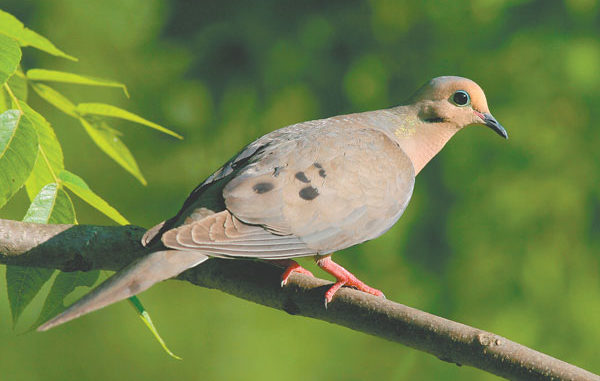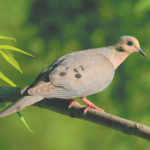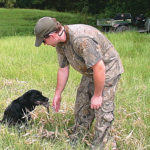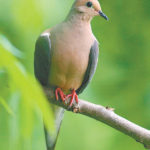
Opening Day of dove season in North Carolina can be an afternoon to remember
The gray, feathered missile bobbed and weaved, riding the afternoon breeze as several loads of No. 8 lead shot narrowly missed making contact and sending it tumbling to the ground.
The dove barely escaped, but it was early on Opening Day, and the hunters in its path across the freshly cut cornfield were still rather rusty and were shooting behind it — which is a common mistake early in the season. The speed of the doves gliding on the breeze was deceptive, and reflexes and shooting eyes hadn’t yet acclimated. It took a box or two of shells and an hour or so of misses before the hunters found their groove and doves began to tumble with regularity.
The next dove that tried to strafe the gleaned corn field wasn’t so lucky. It flew across a father and daughter in a small patch of corn stalks left standing and the young girl connected. It was difficult to tell who was more excited with her success, as she returned to their hideout in the corn while triumphantly holding up her first dove. Dad and daughter both flashed broad grins.
Across a windrow, a father and son were enjoying a similar moment as their retriever returned with the son’s first dove. It didn’t matter that it took almost a box of shells to connect again; they were outdoors together and hunting.
Opening Day dove hunts in North Carolina are a tradition of sorts, part family reunion, part coming-out-party for new hunters, part retraining your eye to allow enough lead that your ounce of shot and the dove arrive at the same place at the same time.
But preparation for the celebration of Labor Day weekend starts well in advance for many North Carolina hunters. Without a good food source, doves are not likely to pay you a visit, and the menu has to be planned months in advance.
David Knox of Roans Branch Hunting Preserve near Bolivia in Brunswick County is like many hunters in that he plants fields with sunflowers, millet and other seed crops in and along corn fields to attract doves. A week or so before the Sept. 3 opener, he’ll harvest the fields, leaving enough grain to attract doves and provide hunters with hiding places while making sure he abides by state and federal law that doesn’t allow baiting, which is basically bringing in something harvested elsewhere to his fields.
Hopefully, enough doves will locate the agricultural buffet to keep shotguns banging and hunters happy.
“Of course, the birds can mess with your plans, too,” Knox said. “One year, the doves flew by our managed fields to swarm on a couple of smaller fields with corn that had just been cut. Luckily, we had leased those fields and were able to move hunters there and switch them out after they reached their limits and get everyone some good shooting.”
Roans Branch is one of a number of commercial dove-hunting facility that offers hunters without access to a private dove field the chance to empty several boxes of shotgun shells in the hope of getting close to or reaching their 15-bird daily bag limits.
The N.C. Wildlife Resources Commission also plants fields specifically for dove hunters across the state, using many of the same planting and harvesting methods as the farmer who lets you bang away at his cut cornfield.
Tom Padgett is a wildlife biologist for the Commission based in the southeastern corner of the state. He said sunflowers and brown top millet are the crops most-often used to attract doves in his area. They are low-maintenance crops, he said, which will bear seeds 60 to 70 days after planting, and they’re dove favorites.
“The way fields are harvested is important to how they attract doves,” Padgett said. “Bare ground is very attractive to doves. They like to feed on the ground and have short legs, which makes it difficult for them to walk in heavy stubble. Some of my best dove hunts have been over fields that have been mowed or burned. Both clear the way for the doves to feed, and once they find these fields they use them until they continue their migration or are forced to move on.”
Padgett said doves have an incredibly high natural mortality rate, which various studies have placed at between 50 and 80 percent. Fortunately, doves are also prolific nesters; he said they can raise as many as six broods during a nesting season, with birds laying two or more eggs per brood.
Hunters have used decoys to attract doves for years, but one recent innovation is carrying artificial sunflower plants into a cut field and inserting them into the ground to create the impression of a small cluster of sunflowers. Doves have a definite preference for sunflower seeds and will seek out these areas over other spots in a field. Do not use real sunflower plants that have been picked from elsewhere and carried in as that would be considered baiting and is illegal. The plants must have grown there or be artificial.
Another preseason suggestion, this one from Knox, is for hunters to “warm up” a little before dove season arrives with a round of trap, skeet or sporting clays to sharpen more-experienced shooting eyes and give beginners a chance to practice swinging and leading.
His other suggestion is to enjoy the day, maybe even getting together for a cookout, barbecue or pig-pickin’ before heading to the field.
“Our dove-hunting package includes Opening Day with lunch and all the trimmings, and then five more Saturdays during the (first) season,” he said.
Carrying water into the field is suggested, especially when retrievers accompany hunters.







Be the first to comment